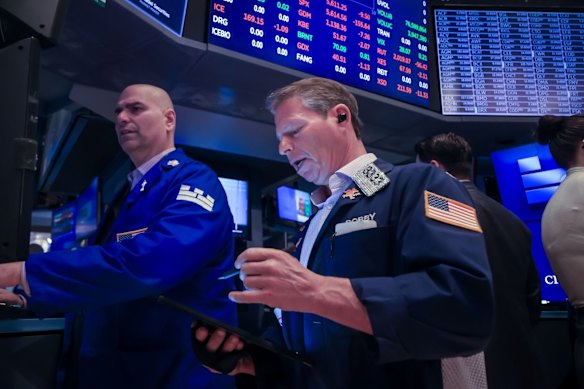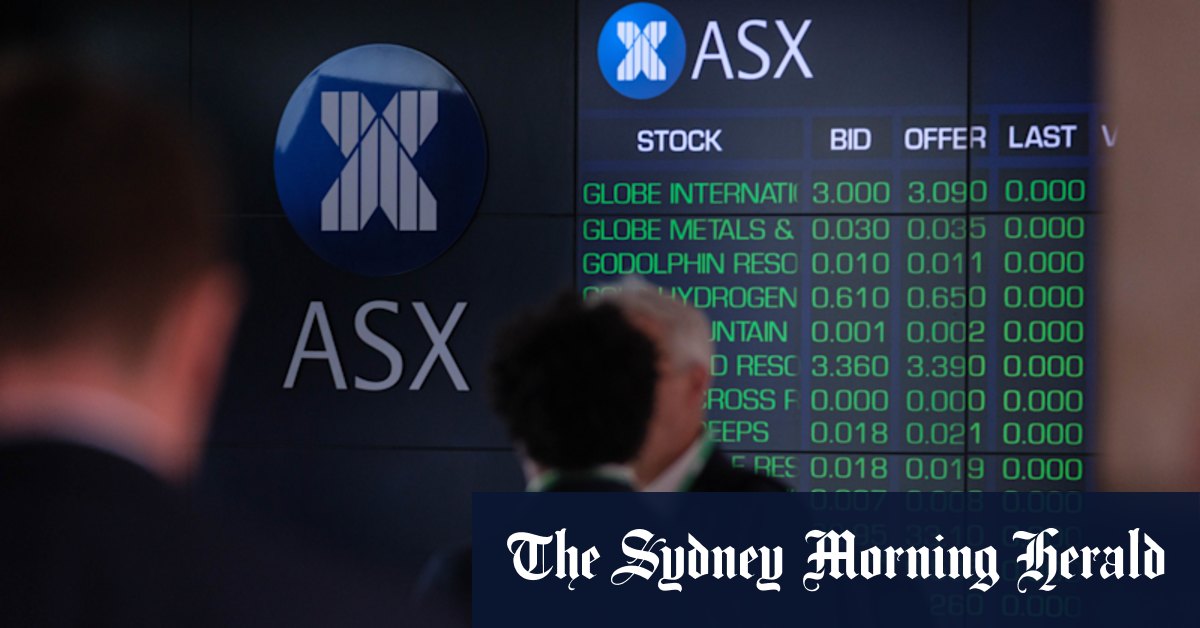Financial stocks were stronger, with Westpac up 1.9 per cent, ANZ rising 1.2 per cent and NAB adding 0.9 per cent. Commonwealth Bank, which will deliver its results on Wednesday, was 01.1 per cent higher.
Loading
Energy stocks were mixed, with Woodside adding 0.7 per cent, Yancoal flat and Santos slipping 0.1 per cent.
The laggards
Consumer discretionary stocks were the worst performing segment, down 1.6 per cent after a strong performance last week as JB Hi-Fi slumped 8.4 per cent to $107.83 despite boosting sales and profits as long-serving CEO Terry Smart announced his departure. He will be replaced by chief operating officer Nick Wells.
The leadership announcement was made on the same day its full-year results were released, revealing a 10 per cent rise in sales to $10.6 billion, and a 5.4 per cent growth in profits to $462.4 million for fiscal 2025.
The company has announced a fully franked final dividend of 105¢ a share, bringing the total dividend to 275¢ a share. It has also declared a special dividend of 100¢ a share.
Wesfarmers fell 1.8 per cent, Aristocrat Leisure was down 1.1 per cent and Harvey Norman slipped 2.5 per cent.
Australia’s tech sector was underperforming the market, down 0.4 per cent as TechnologyOne sank almost 2.9 per cent to $39.18 and Xero lost 3 per cent.
Gold miners took a breather as the precious metal eased around 1.5 per cent to $US3437.1 ($5269) an ounce.
The lowdown
The Australian sharemarket has made a bright start to the week ahead of Tuesday’s Reserve Bank decision, with financial markets expecting the central bank to deliver the third cut in official interest rates this year.
The top 200 briefly hit 8852.3, topping last week’s intraday record of 8848.8 amid high expectations of a cut, Moomoo market strategist Michael McCarthy said.
“What many analysts seem to overlook is that just because the RBA [Reserve Bank of Australia] can cut doesn’t mean it will cut,” he said.
“While core inflation at 2.7 per cent gives the RBA room to move, an unemployment rate of 4.3 per cent means it’s not under any pressure to do so.”
A refusal to cut on Tuesday could have a significant impact on the share market, McCarthy said.
“We expect the RBA to cut the cash rate by 25 basis points next week to 3.6 per cent… The overall tone of the statement will likely be neutral with a dovish lean,” Citi analysts wrote in a note.
All eyes will be on Tuesday’s decision as earnings season is hitting its stride, with CBA, Seven West, AGL, IAG, Suncorp, Telstra, Cochlear and Origin among companies reporting this week.
Meanwhile, options traders are using currencies such as the Australian dollar and euro to express bearish US dollar views after recent disappointing American economic data.
The Aussie is being supported by the Reserve Bank’s “cautious and gradual” stance on easing, as well as improving risk sentiment. The euro’s allure has grown from expectations an increase in regional defence spending will support the euro-zone economy, and a more hawkish-sounding European Central Bank. Meanwhile, things look rockier for the US dollar as data showed jobs growth missed expectations in July with downward revisions to prior months as well.
Standard Chartered Bank has seen “a lot of interest” in euro-US dollar and Australian dollar-US dollar call options after non-farm payrolls, according to Saurabh Tandon, global head of foreign-exchange options in Singapore. The market is focusing on upcoming events such as US inflation and the Federal Reserve’s Jackson Hole symposium, he said.
National Australia Bank has seen a pick-up in demand for bullish Australian dollar option wagers, as well as for those on the New Zealand dollar.
“Following the recent non-farm payrolls, we’ve observed significant activity in AUD/USD and NZD/USD short-dated call options, in anticipation of a busy data week, including the US CPI release and the RBA meeting.” said Con Davelis, Sydney-based head of FX options at the bank.
On Friday, the S&P 500 rose 0.8 per cent, finishing just shy of the record it set last week. The benchmark index also wiped out its losses from a slide last week. The Dow Jones rose 0.5 per cent and the Nasdaq composite added 1 per cent to the all-time high it had set a day earlier.
Technology companies, with their hefty stock values, did much of the heavy lifting for Wall Street. Nvidia rose 1.1 per cent and Apple gained 4.2 per cent.

Wall Street posted another winning week.Credit: Bloomberg
Gilead Sciences jumped 8.3 per cent for one of the market’s biggest gains. It reported financial results that easily beat analysts’ forecasts, while also raising its earnings forecast for the year. Expedia Group rose 4.1 per cent after also reporting encouraging financial results.
Loading
They are among the final big batch of companies within the S&P 500 to report mostly strong financial results for the second quarter. Still, many have warned that current tariffs could cut into their profits.
Financial sector stocks also helped drive the market higher. Bank of America gained 2.4 per cent and Mastercard rose 2.3 per cent.
Elsewhere in the market, entertainment giant Paramount Skydance slid 10.5 per cent a day after the company was created by the closing of an $US8 billion ($12.3 billion) merger of Skydance and Paramount. Shares in rival Warner Bros. Discovery sank 8 per cent.
The main focus throughout the week has been on President Donald Trump’s trade war and its potential impact on the US economy, as well as the Federal Reserve’s interest rate policy. Trump began imposing higher import taxes on dozens of countries on Thursday.
Still, the market appeared to largely shrug off the latest tariff escalation.
“The S&P 500’s rebound this week may highlight the extent to which the market is becoming numb to tariff headlines,” said Daniel Skelly, head of Morgan Stanley’s wealth management market research and strategy team.
The unknown path of the economy amid an unpredictable tariff policy has been the key reason for the Fed to hold its benchmark interest rate steady.
Loading
Fed chair Jerome Powell, though, has been under increasing pressure from Trump to cut interest rates. Policy decisions aren’t made solely by the Fed chair. All 12 members of the Federal Open Market Committee vote on interest rate changes.
Trump has an opportunity to exert more control over the Fed following his nomination of Stephen Miran to a vacancy on the Fed’s board of governors. Miran is a top economic adviser to Trump and is a near-certain vote in support of lower interest rates.
The Fed’s last decision to hold interest rates steady included two votes to lower interest rates. Its next meeting is in September, and Wall Street is overwhelmingly betting that the central bank will cut interest rates by a quarter of a percentage point.
Wall Street and the Fed will get more insight next week on inflation’s temperature and the economy. The government will publish updates on inflation at both the consumer and wholesale levels, along with a report on retail sales.
“We believe stocks will stay supported amid solid fundamentals, but fresh headlines in the coming week may challenge investor sentiment that remains vulnerable to tariff, economic and geopolitical risks,” said Ulrike Hoffmann-Burchardi, chief investment officer for the Americas and global head of equities at UBS Global Wealth Management.
With AAP, AP, Bloomberg
The Market Recap newsletter is a wrap of the day’s trading. Get it each weekday afternoon.
